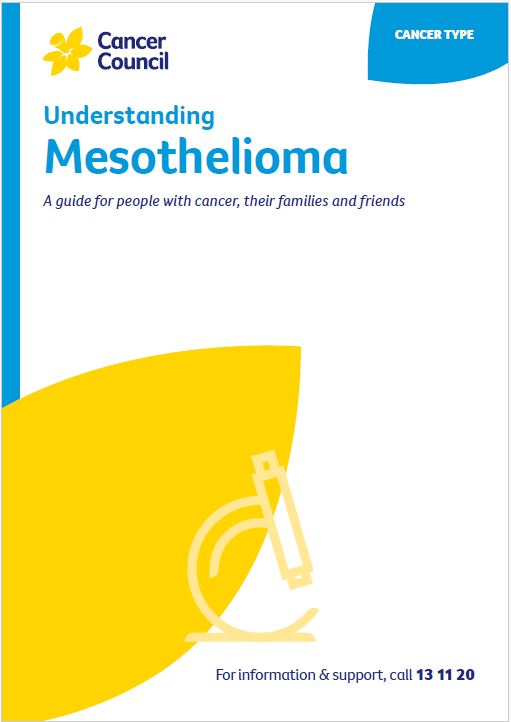- Home
- Pleural mesothelioma
- Diagnosis
- Tests
- Biopsy
Biopsy for pleural mesothelioma
A biopsy is the main test used to diagnose pleural mesothelioma. It involves removing a sample of tissue, which is examined under a microscope by a specialist doctor called a pathologist.
The pathologist looks for cell changes to work out if the tumour is mesothelioma and, if so, the type of mesothelioma cells present.
Learn more about:
The main types of mesothelioma cells
There are 3 main types of mesothelioma cells :
| Epithelioid | cells look similar to normal mesothelial cells. This is the most common type, making up about 75% of cases. |
| Sarcomatoid (fibrous mesothelioma) | cells have changed and look like cells from fibrous tissue. This type makes up about 10–15% of cases. |
| Mixed or biphasic | has epithelioid and sarcomatoid cells. This type makes up about 10% of all cases. |
Ways to take a biopsy for mesothelioma
A biopsy can be taken in different ways. The choice of biopsy will depend on your general health and fitness, and how suitable the tumour is for sampling using one of the methods described below.
Keyhole surgery (VATS or laparoscopy) is the most commonly used biopsy technique for mesothelioma, as both tissue samples and fluid can be removed for testing. Obtaining a sample can be challenging, so a respiratory physician or gastroenterologist, radiologist, surgeon and pathologist may all be involved.
Video-assisted thoracoscopic surgery (VATS)
Sometimes called a thoracoscopy, VATS is used to obtain a tissue sample from the lining of the lungs (pleura).
How it’s done – You will be given a general anaesthetic, then a thin tube with a light and camera (thoracoscope) will be inserted through a few small cuts in your chest. Tissue samples can be taken through the tube and sent to a laboratory for testing. If fluid has built up around the lungs and is causing breathlessness, it can be drained during the VATS and you may have a pleurodesis to prevent the fluid building up again. You will usually be given medicine for any pain you feel after VATS.
Laparoscopy
This is used to get a tissue sample from the lining of the abdomen (peritoneum).
How it’s done – You will be given a general anaesthetic, then a thin tube with a light and camera will be inserted through small cuts made in your abdomen. Tissue samples can be removed through the tube and sent to a laboratory for testing. If fluid has built up in the abdomen, it can be drained during the laparoscopy. Any infections that develop will be treated with antibiotics.
CT-guided core biopsy
A CT-guided core biopsy may be used instead of VATS or laparoscopy when there is a large mass but no fluid.
How it’s done – You will be given a local anaesthetic. Using a CT scan for guidance, the doctor inserts a needle through the skin to remove a small piece of tumour from the lining of the lungs or abdomen.
During a CT-guided core biopsy, you will need to lie still on a table for about 30 minutes. You will be monitored for a few hours afterwards. There is a small risk of damaging the lung, but this can be treated if it does occur.
Draining build-up of fluid
When you first have symptoms of mesothelioma, you are likely to have a build-up of fluid in the space around your lungs or in your abdomen. Fluid around the lungs is called pleural effusion and can make it hard to breathe. Fluid in the abdomen is called ascites and may make it swollen and uncomfortable.
Before further tests or treatment, your doctor may drain the collection of fluid to help ease symptoms. When fluid is drained from the pleura, it is called a pleural tap, pleurocentesis or thoracentesis; when fluid is drained from the peritoneum, it is called a peritoneal tap or paracentesis.
Draining the fluid may be done at the same time as VATS or laparoscopy and the fluid may be tested to look for mesothelioma.
→ READ MORE: Other tests for pleural mesothelioma
Podcast: Tests and Cancer
Listen to more episodes of our podcast for people affected by cancer
More resources
All updated content has been clinically reviewed by A/Prof Anthony Linton, Medical Oncologist, Concord Cancer Centre and Concord Repatriation General Hospital, NSW; Dr Naveed Alam, Thoracic Surgeon, St Vincent’s Private Hospital Melbourne and Monash Medical Centre, VIC; Prof David Morris, Peritonectomy Surgeon, St George Hospital and UNSW, NSW. This edition is based on the previous edition, which was reviewed by the following panel: A/Prof Anthony Linton (see above); Dr Naveed Alam, (see above); Donatella Arnoldo, Consumer; Polly Baldwin, 13 11 20 Consultant, Cancer Council SA; Dr Melvin (Wee Loong) Chin, Medical Oncologist, Sir Charles Gairdner Hospital and National Centre for Asbestos Related Diseases, WA; Prof Kwun Fong, Thoracic and Sleep Physician and Director, UQ Thoracic Research Centre, The Prince Charles Hospital, and Professor of Medicine, The University of Queensland, QLD; Vicki Hamilton OAM, Consumer and CEO, Asbestos Council of Victoria/ GARDS Inc., VIC; Dr Susan Harden, Radiation Oncologist, Peter MacCallum Cancer Centre, VIC; Penny Jacomos, Social Worker, Asbestos Diseases Society of South Australia, SA; Prof Brian Le, Director, Parkville Integrated Palliative Care Service, The Royal Melbourne Hospital and Peter MacCallum Cancer Centre, VIC; Lung Cancer Support Nurses, Lung Foundation Australia; Jocelyn McLean, Mesothelioma Support Coordinator, Asbestos Diseases Research Institute, NSW; Prof David Morris (see above); Joanne Oates, Registered Occupational Therapist, Expert Witness in Dust Diseases, and Director, Evaluate, NSW; Chris Sheppard and Adam Barlow, RMB Lawyers.
View the Cancer Council NSW editorial policy.
View all publications or call 13 11 20 for free printed copies.

